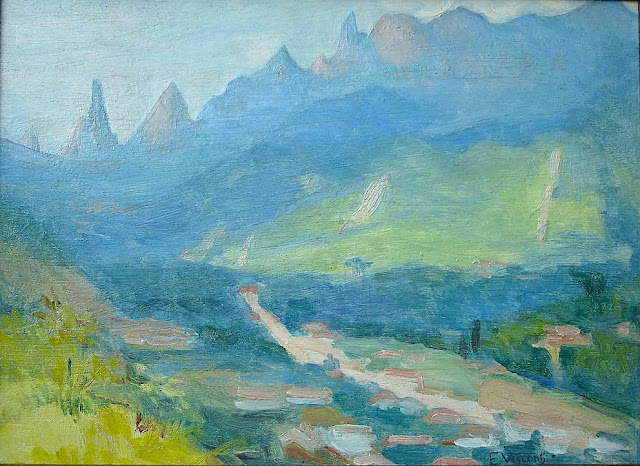AUGUSTE CHABAUD (1882 - 1955)
Les Crêtes de Baumayrane (315m)
France (Bouches du Rhône)
La montagne
Les Crêtes de Baumayrane (315m) connues aussi sous le nom de "Rocher des Baux-de-Provence", est un site emblématique situé dans le massif des Alpilles. Cette imposante formation rocheuse calcaire domine la région offre des vues panoramiques et abritant les vestiges d’un passé riche en événements.
Le Rocher des Baux-de-Provence est habité dès l’Antiquité par les Celtes avant de devenir une colonie romaine. Au Moyen Âge, le site est le siège d’une puissante seigneurie. Les seigneurs des Baux y ont laissé une empreinte durable. Le château des Baux, situé au sommet du rocher, est un exemple impressionnant d’architecture médiévale et a été le témoin de nombreuses batailles ainsi que de conflits au fil des siècles. Sous la Renaissance, le Rocher des Baux-de-Provence a connu un essor culturel, devenant un centre artistique et littéraire. que la montée en puissance des guerres de religion.a tempéré. Les guerres, l’érosion et les ravages du temps ont contribué à sa dégradation. Au 19e siècle, Prosper Mérimée, inspecteur des monuments historiques, a contribué à la préservation du site en inscrivant le château des Baux ainsi que les ruines environnantes sur la liste des monuments historiques.
Auguste Elysée Chabaud est un peintre et sculpteur français.Entré à l'école des beaux-arts d'Avignon en 1896, Auguste Chabaud a pour maître Pierre Grivolas. Puis en 1899, il part à Paris poursuivre ses études à l'Académie Julian et à École des beaux-arts, dans l'atelier de Fernand Cormon (1845-1924). Il rencontre Henri Matisse et André Derain. La propriété viticole de ses parents subit la crise de 1900, obligeant Auguste Chabaud à redescendre dans le sud.
En 1901, Auguste Chabaud doit gagner sa vie, il s'embarque comme pilotin sur un navire et découvre la côte occidentale africaine. La même année son père meurt ; il hérite avec son frère de la propriété viticole et des terres que seul son frère va gérer. À cette période, Chabaud travaille beaucoup sur papiers de boucherie.
De 1903 à 1906, il fait son service militaire en Tunisie d'où il va revenir avec des carnets de croquis remplis d'images locales, dont de nombreux dessins de militaires, d'indigènes et de scènes de bar peuplés de filles et de marins.
De retour à Paris, Chabaud débute en 1907 au Salon des indépendants exposant parmi les fauves. Il va découvrir une nouvelle vie, celle de la nuit parisienne et des cabarets. Les collectionneurs commencent à s'intéresser à son travail. À Montmartreo ù il a son atelier, il peint les rues et les places animées ou désertes, les scènes de la vie nocturne et les maisons closes.
En 1911, il entame sa période cubiste, travaille de grands formats et sculpte.
S'ensuivent de nombreuses expositions dont celle de New York en 1913 où il expose aux côtés d'Henri Matisse, André Derain, Maurice de Vlaminck et Pablo Picasso, puis à Chicago et Boston. Ses toiles de la période fauve décrivent la vie nocturne parisienne : cabarets, cafés théâtre, prostituées, aux teintes de couleurs vives (jaune, rouge) contrastant avec les couleurs de la nuit (bleu marine, noir).
À son retour de la Première Guerre mondiale, en 1919, Auguste Chabaud s'installe définitivement à Graveson, dans la propriété familiale, le mas de Martin situé au pied de la Montagnette. À partir de 1920, il entame sa période bleue où il emploie le bleu de Prusse à l'état pur, dans laquelle la Provence, ses personnages et ses coutumes sont mis en avant. Le Sud, qu'il n'a jamais cessé de peindre, même dans sa période parisienne, va l'occuper désormais exclusivement. Comme l'avait fait Paul Cézanne avec la montagne Sainte-Victoire, Auguste Chabaud immortalisera « la montagnette », peignant des scènes de campagne, des paysans arpentant les collines et sentiers des Alpilles. Il y restera jusqu'à la fin de sa vie, vivant reclus dans sa maison avec sa femme et ses sept enfants. Surnommé l'« ermite de Graveson », il meurt en 1955.
Certaines de ses œuvres sont conservées à Marseille au musée Cantini, à Paris au musée national d'Art moderne, au musée d'Art moderne de la ville de Paris, et à Genève au Petit Palais. En 1992, un musée en son honneur est ouvert à Graveson. Des peintres lui rendent régulièrement hommage, comme Claude Viallat en 2003.
________________________________________
2025 - Gravir les montagnes en peinture
Un blog de Francis Rousseau

,%201878%E2%80%931879.%20Oil%20on%20canvas-%20BArnes%20foundation%20.jpg)
%20The%20Village%20of%20Vauvenargues,%20April%2029%E2%80%9330,%201959%20.png)
%20Les%20Cypre%CC%81s%20(The%20Cypresses)(1907)%20Oil%20on%20board,%2024%20x%2033%20cm.%20Private%20Collection%20(Switzerland)LA.jpgSAint%20Victoire.jpg)


.JPG)


,%201885%E2%80%931886-%20Barnes%20Foundation.jpg)







